Simon puts the current generation KTM 690 Duke R through it's paces, with the bike delivering more than ever before... Review by Simon Harris, Images: Jeff Ware, KTM
On the right kind of road and in the right hands the KTM 690 Duke R is undoubtedly an absolute giant killer of a bike, a David constantly looking for a Goliath.
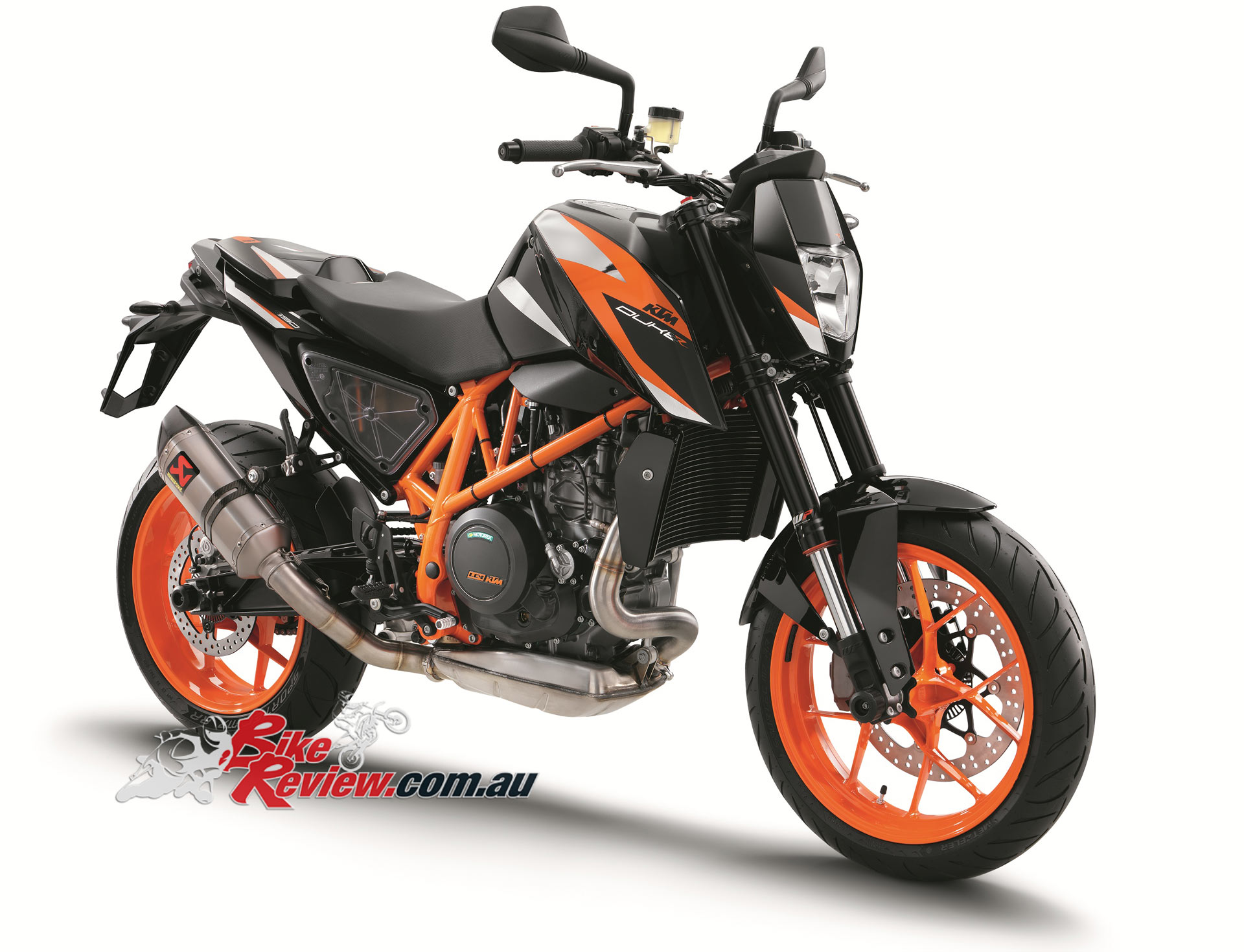
The 690 R comes jam packed with goodies. Versus the 690, it has a 30mm taller seat height, fully adjustable WP suspension, cornering ABS, disenegageable, supermoto mode, 1500mm suspension travel v 135mm, MTC (3-mode, disengageable), updated graphics and an Akrapovic slip-on.
The Duke offers an unbridled combination of phat torque, high compression and large capacity single-cylinder drive with a relentless hunger for scaling the tacho to the rev ceiling, like no other single I have ever come across.
It is a diamond of a thing and really represents the current pinnacle of single-cylinder performance road bike technology.
The 690R is a package that is scintillating to ride – be aggressive, be laid back, be pompous, it doesn’t care what you are and is always ready to pack a wallop and dig the rear rubber deep into the road and fire you forward.
Gulp your Vitamin C down to stave off ailments ‘coz it’s a sublime machine that you will want to ride all year long.
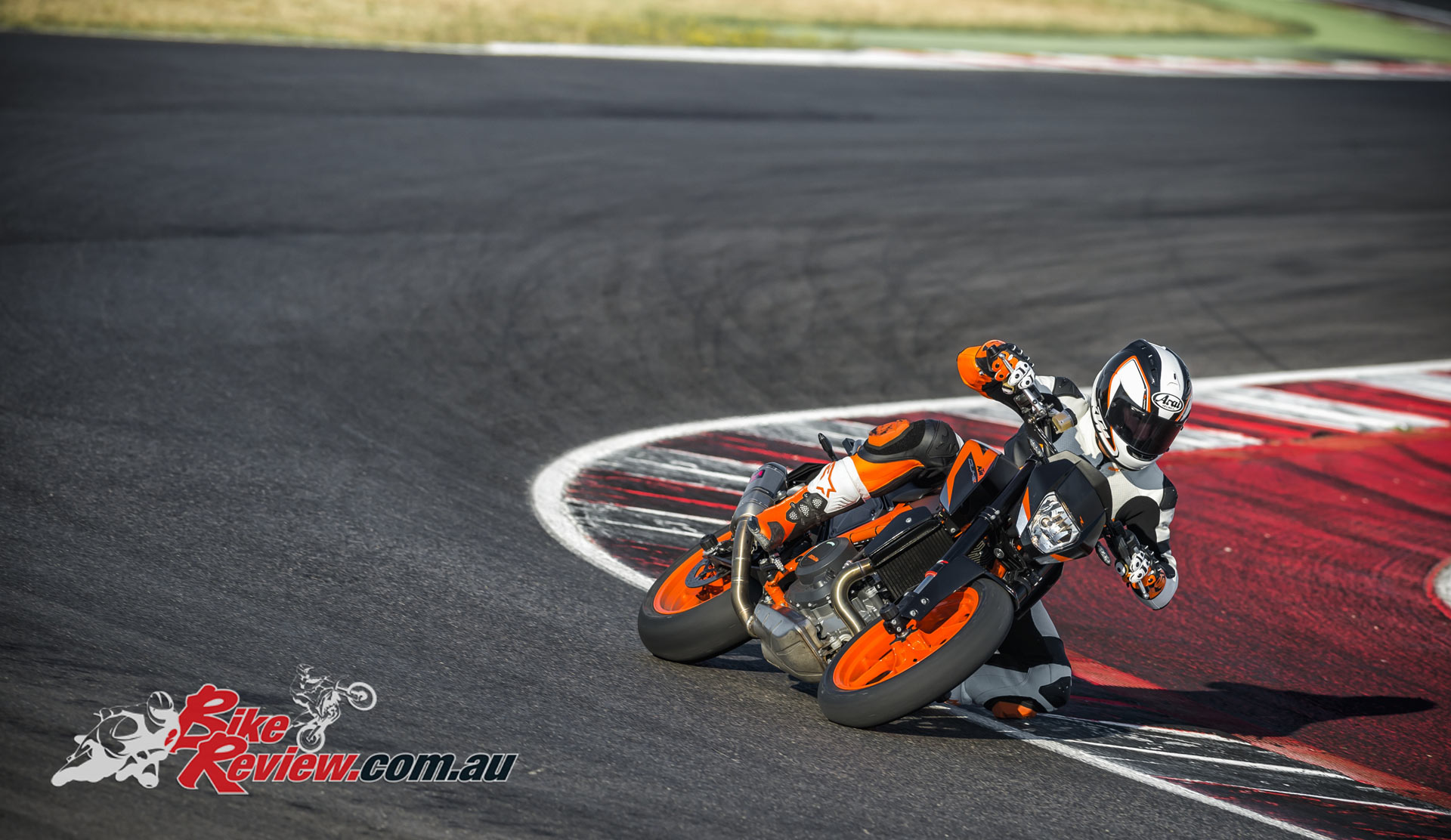
The 690R is a fantastic handling little middleweight. It has a good balanced chassis and top end suspension. The Metzeler M7s are a good tyre but would be better replaced for more sportier riders.
KTM have worked hard on the Duke series – the Duke 690 stocker is a great bike in its own right – however, they have really gone to town on the R. No way is this just a re-decalled and repainted version, it has some significant changes to make an already good thing simply darn good.
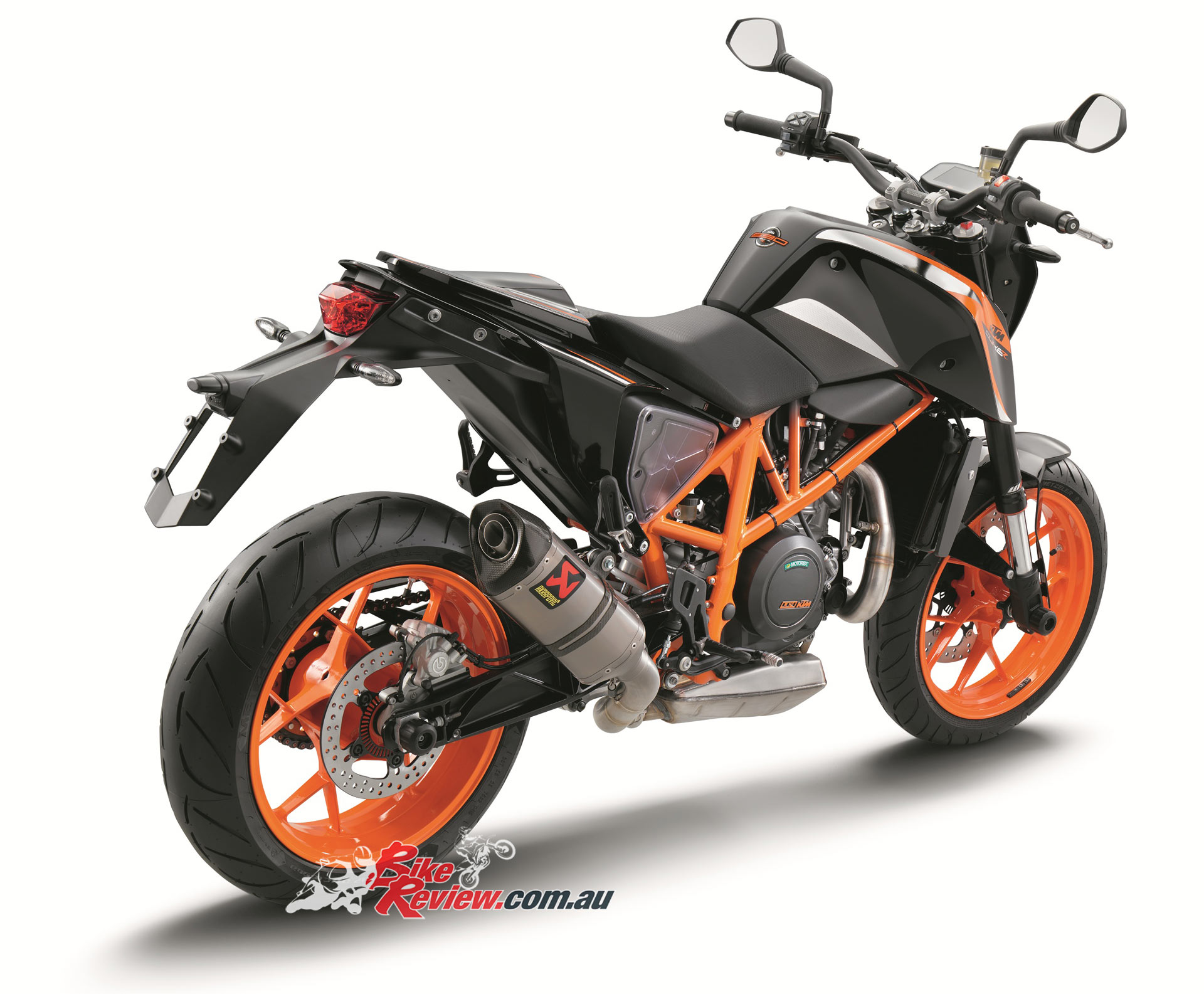
The slip-on Akrapovic is road legal and comes standard with the 690 Duke R. It has a noise limiting bung that can easily be removed.
Before the enhancements the basic premise of the machine is this – bountiful and easily accessible power from the big bore to medium stroke engine. A light weight and slender profile for nimble handling, plus of course first class ancillaries to keep everything floating on the rubber, and an electronic aid package to bring it all home.
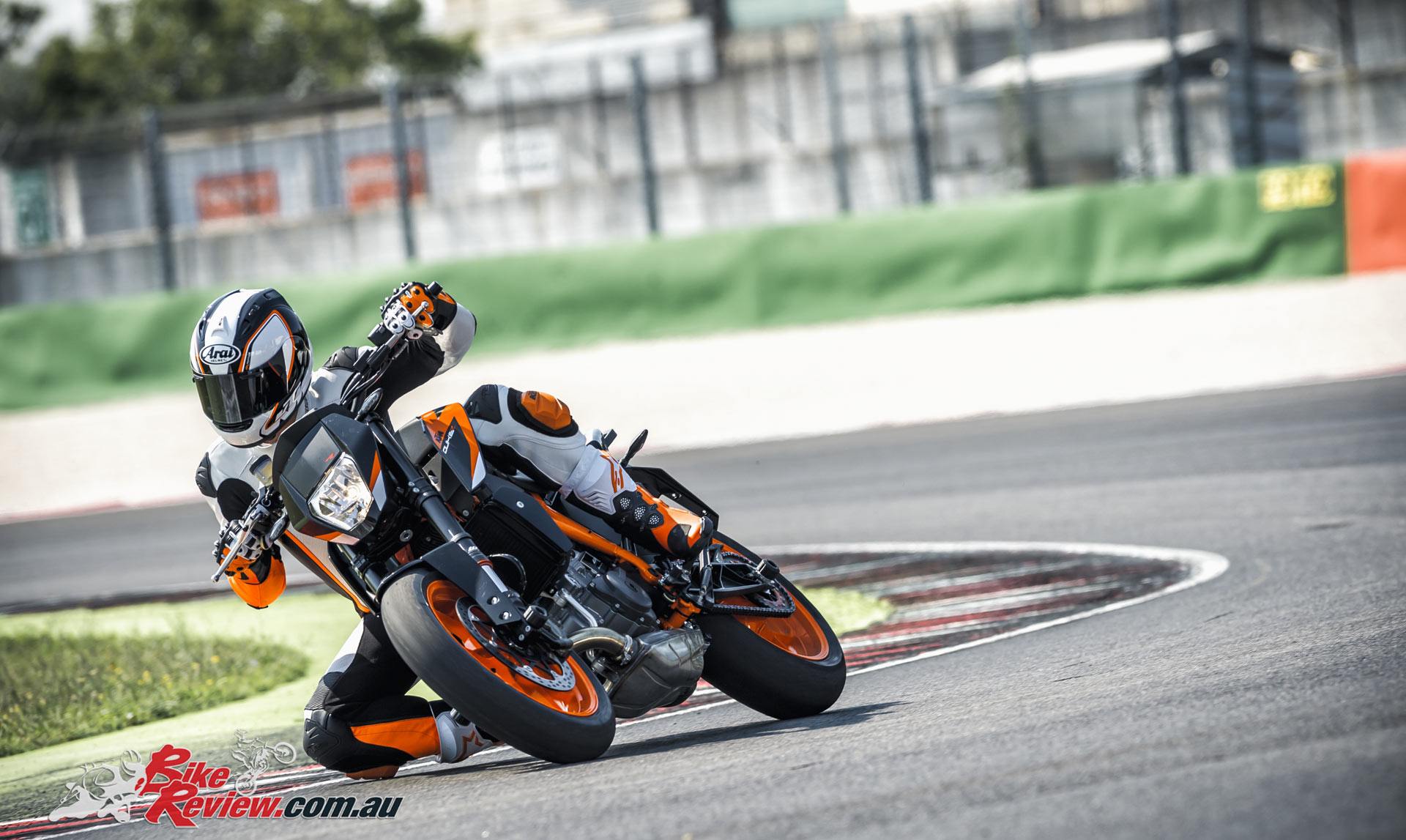
Ground clearance is not bad on the R. It has alloy rearsets anodised in black as opposed to the standard version 690 which has cast items. Gearing is tall so the bike likes revs to get off turns fast.
In the design room, the aesthetics department have not deviated greatly from the semi-farm bike look – sorry “motard,” – in some aspects, like the tall front end and hunched appearance, but look past the now standard KTM chiselled lines and check the sub-frame – it’s die-cast alloy and nicely finished.
The swingarm, with its strengthening webs on the outside is again strange but true, and the Cro-Mo steel tube trellis frame featuring circular and oval sections hang it all together solidly. There is humour too – a semi-opaque airbox cover. Hmmmm.
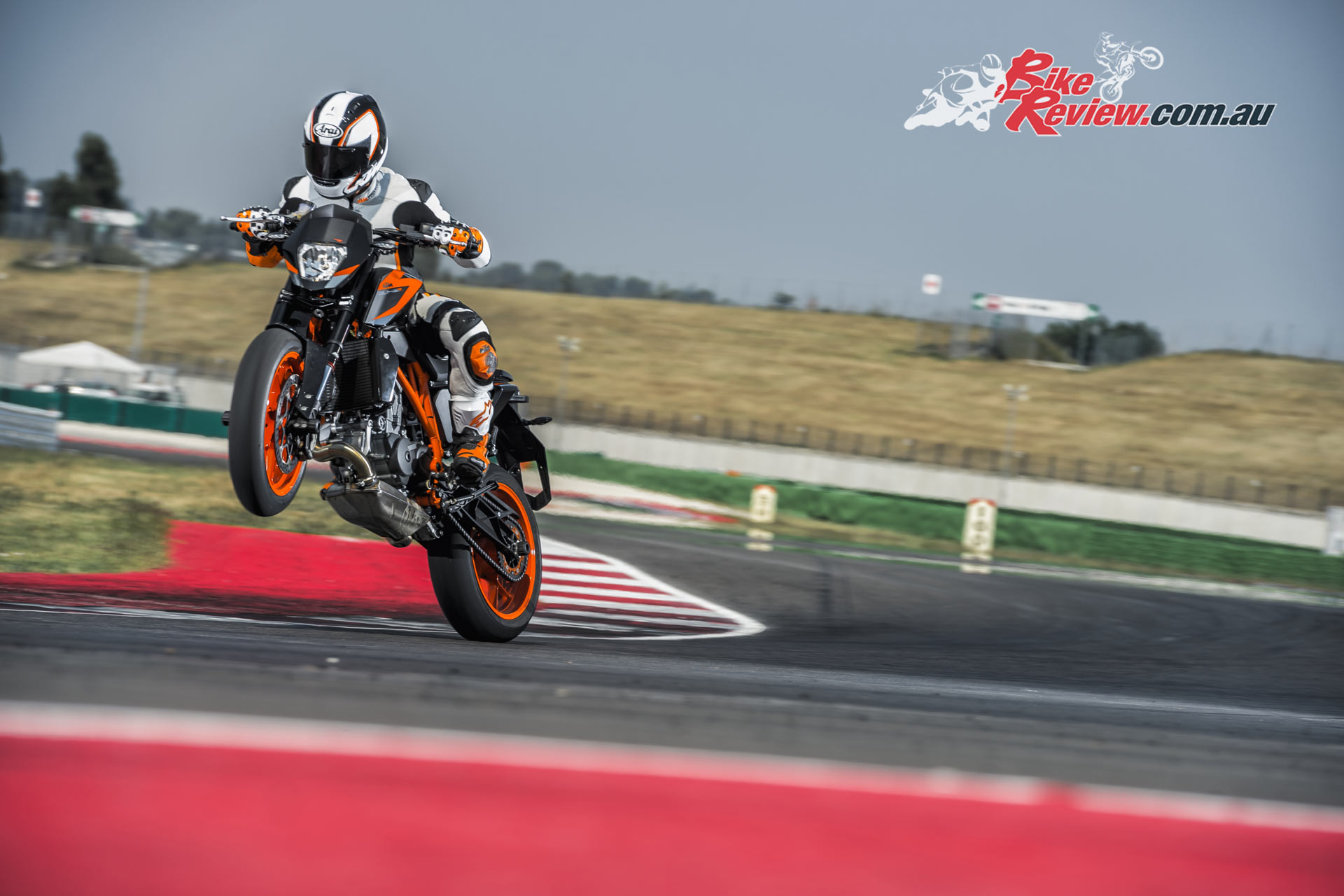
With strong mid range and an impressive peak output of 75hp at 8000rpm the 690 is a cracker of a single and loves to do wheelies like this.
The powertrain is the heart of it all and sits as a high compression, four-valve 102 x 84.5mm stroke single. Significant improvements for this generation include the twin-plug head, now with different mapping for each plug to ensure ultimate combustion efficiency for all circumstances and the lean angle sensitive traction control and ABS functions.
The lean angle sensitive stuff actually now includes real-time lean angle information as part of the computer processing data to make on the fly adjustments for maximum safety and maximum velocity. This comes into play especially when hard on the gas or applying brake at lean.
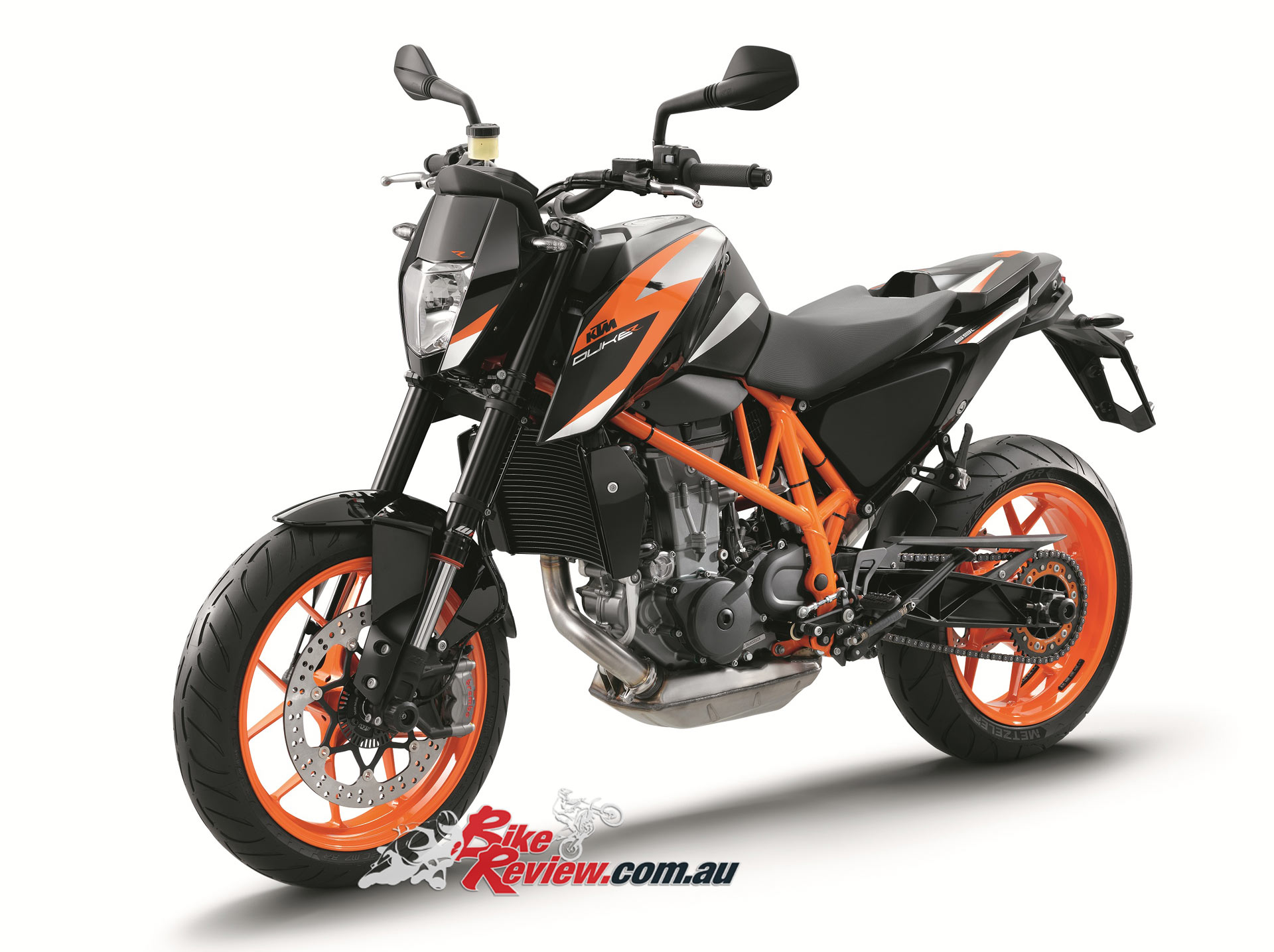
The KTM 690 Duke R is close to a perfect middleweight naked only let down by a single front rotor and not enough braking performance even with the up-spec set-up on the R versus the 690.
This level of sophistication represents the next step in terms of in-ride electronic optimisation and compensation capability. The valve train runs two valve actuation techniques simultaneously, which KTM claim to make precise valve timing easier, with intakes actuated directly off the cam and exhaust valves via a forked rocker.
In this guise, the cam also performs duties as a secondary balancer shaft. Very sophisticated engineering, but noticeable on the road by way of the engine being impeccably smooth across its entire operating spectrum, which is a full 1000rpm wider than before, and super responsive to the most meagre change by way of the fly-by-wire throttle system.
Instant drive is available everywhere and when the mill is hovering over 5000rpm, fireworks happen when you crack the throttle… this firebrand bangs the rev limiter in mere blinks. Punch out of corners is very positive indeed and it veritably hurtles between bends in the twisty stuff as fast as you are willing to push.
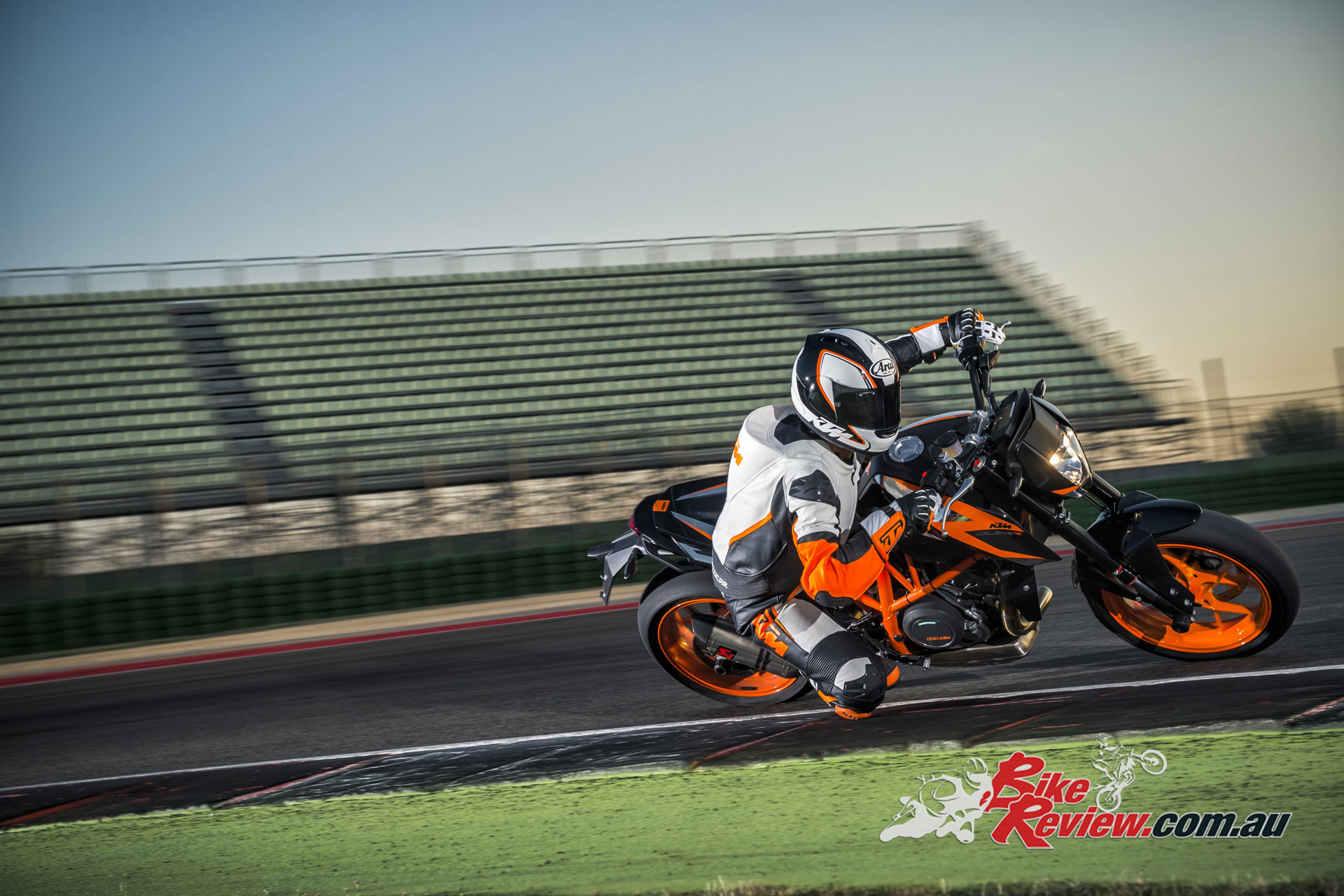
The 690 R is at home on the track as we found out on The Farm last time we tested one. By nature it prefers the tighter stuff over the open sweepers but can still hold its own against the multi-cylinder bikes.
The engine is equipped with a very sleek slipper clutch that mitigates the potential for compression to cause rear wheel bounce or lock-up with the result of unwieldy corner entry, with a smoothness in operation that makes it almost unnoticeable, but well appreciated.
Again the engineering team have done a fine job of virtually erasing any tendency for the engine and supporting aid mechanisms to interfere with or obstruct what you want the bike to do.
The gearing is well matched for real-world performance and allows the front to loft under power in the first two gears if you so wish as well as to cover distance comfortably at relatively high speed. There is a slight hunting effect at times around the 3500 to 4000rpm mark at pedestrian speeds with tiny throttle openings.
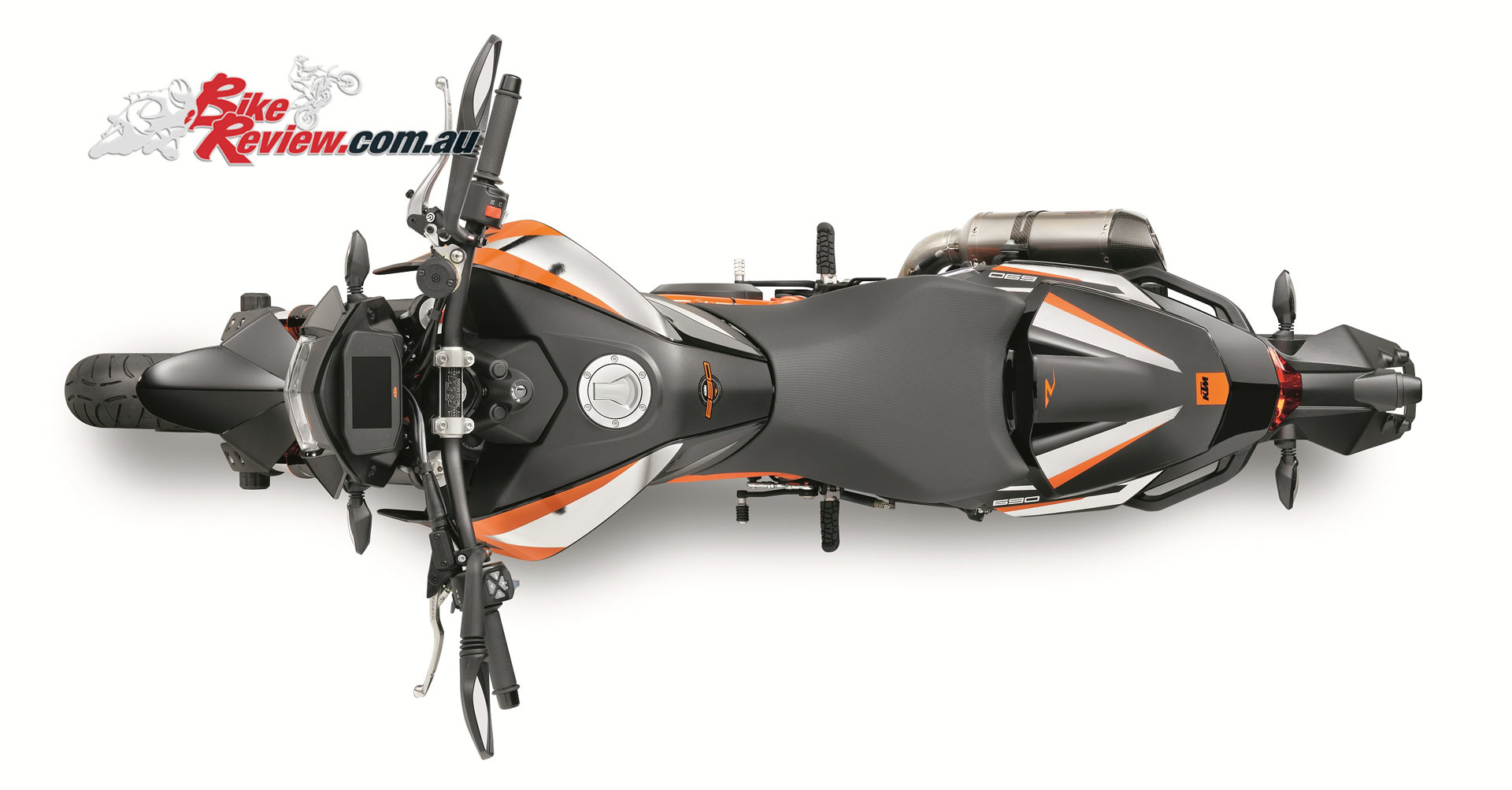
Being a single-cylinder bike the KTM is super slim but the seat is broad enough for an hour or two on the open road. It really has an off-road-motard-nakebike combo feel to it. We loved it.
This can be annoying, but that is what our not so bizarrely restrictive speed limits are exactly designed for. Shifting up or down the ‘box is smooth and pretty much effortless with the controls at both hand and feet, however, for an up-spec’d machine with this level of performance a quick-shifter is kind of a standard expectation that would further make fast riding easier. Perhaps next year…
Interfacing with you all that is going on in and around the bike is the TFT display, which is pretty good at delivering the necessary information in an easily readable but fully digital way. Included are three differing colour-codes for each riding mode.
Speaking of the three riding modes, each mode encompasses various settings for ABS, TC, anti-wheelie and so on, when they kick in. The more radical the mode, the smaller the tolerances are and the less intrusive each system becomes.
These all work in combination, of course, with a lot of cunning algorithms to ensure how and when each one activates, and that its proportion against other factors is properly determined.
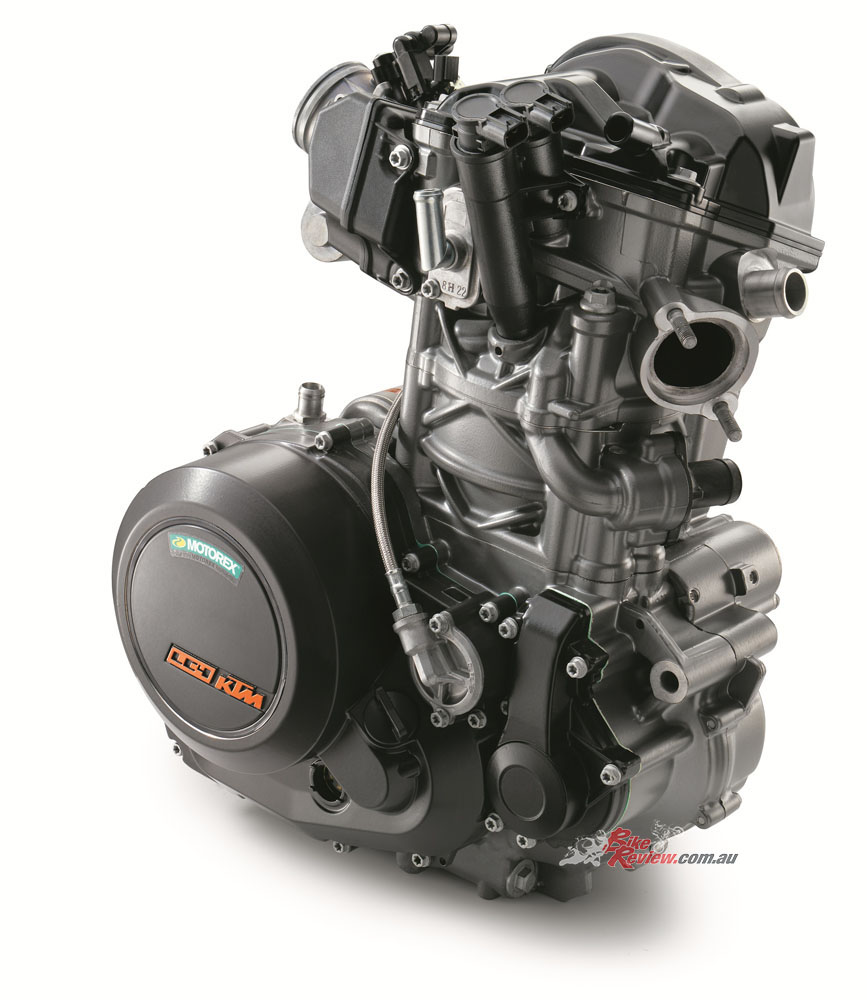
The mighty LC4 engine has a bore and stroke of 105 x 80mm making it a revvy beast. It has a whopping big 50mm throttle-body and 12.7:1 compression, putting out 74Nm of torque. It runs a SOHC that doubles as a balance shaft and runs a finger follower exhaust sliding surface rocker arm along with two oil pumps. It also features a slipper clutch and is a compact unit.
There is a lot of customisation available for the ultra sports mode, however, time did not allow for a thorough investigation. As a brief test to the variations of modes, I did switch between all modes over the same stretch and found that there appeared to be little in terms of differences in the obvious engine characteristics.
This can be seen as testament to how well the engine power is curtailed and controlled but not neutered by the electronics. The difference in behaviour out of turns was more noticeable however, in that there felt to be a more organised delivery of power; more measured, but still very exciting. When in rain mode I was quite surprised at how often the traction control indicators on the display were being activated.
Ride ergonomics are treated quite importantly and the Duke is comfortable to ride calmly and relaxed in a more doggie-beg posture, as well as head down between the elbows and wiggling across and over the improved (and 30mm taller) seat when you are in a more lively mood. The handlebars hold the decent mirrors quite well, but may prove a bit wide in tight traffic.
The ‘bars are, however, supreme in making high speed direction changes and adjustments at lean a snap that requires little physical effort. The sub-150kg dry weight and machine/rider mass distribution has a huge hand in this too.
The ability for you to control the machine without hesitation is comforting and confidence inspiring, and, coupled with excellent ground clearance and high quality tyres may cause you to require replacing your boots more often.
Suspension is multi-adjustable WP at both ends. The forks feature compression and rebound damping control in separate legs for simplified oil circuitry and easier setup. I can dig that concept, and Jeff’s setup of approximately 30-odd percent rebound and compression proved spot-on for my sense of feel.
The rear suspension felt significantly harder than the non-R version (even with greater stroke) and not quite so limo-like in rider comfort, however, it was certainly sharper when cornering by pushing more load on to the front end as well as speeding up bump control responses.
The factory claims that the triple clamps are manufactured in such a way as to match fork flex for maximum feedback at lean, on the brakes, and such. I cannot testify to that except to say that the inherent feeling of grip sensitivity offered is extremely good, even on cold hands.
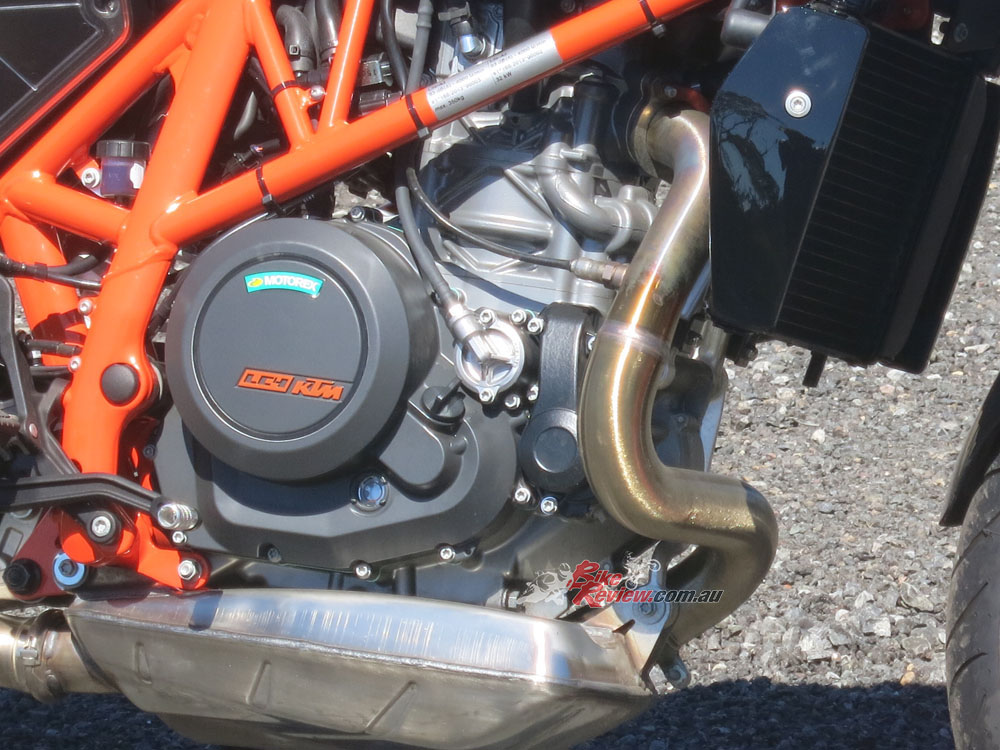
The collector box is huge and it would be great to fit a full system to free the space up and help the engine breath.
The Duke 690R offers both levels of sophistication and performance that have allowed KTM to claim the mantle of super-single maker. When you are on-board the Duke R, this becomes obvious as everything about the bike is formulated using a philosophy of ultimate performance.
Extreme but not stifling rider safety, absolute light weight, and a practical engine configuration that has been so well engineered as to make a formidable opponent to many multi-cylinder machines.
The Duke 690R is a very well-engineered machine on so many levels that it is difficult to assess without seeming biased in some way – you really must swallow the vitamin C and check one out. Exhilarating.
KTM hit the bulls-eye with the 690 Dukes. The employment of cutting edge technologies around a simple core in a lightweight but highly developed chassis has proven popular since the Duke debuted. The current range is the culmination of constant R&D that provides a fantastic and exciting motorcycling experience.
The “standard” Duke makes the perfect riding tool, like a Swiss army knife it has the goodies to take on any situation with both finesse and urgency. The lower seat and pegs and softer suspension make this version a little more genial. It lacks the facility for customisation of the electronics and can feel a bit harangued if over exerted, though.
The R version shows how the extra money is purposefully allocated by the up-spec suspension and brakes, Akrapovic exhaust and full electronics control. Outright static performance figures are almost identical between the two, but the scalpel-like R is a very fast machine capable of tangoing with anyone.
Specifications: 2016 KM 690 Duke R
Price: $14,995 + ORC
Warranty: Two year, unlimited kilometre
Colours: Back/white and black
Claimed power: 55kW[73hp]@8000rpm
Claimed torque: 74Nm[54.5ft-lbs]@6500rpm
Wet weight: 147.5kg
Fuel capacity: 14L
Engine: Liquid-cooled, single-cylinder, four-stroke, 102 x 84.5mm bore x stroke, 690cc, 12.7:1 compression, six-speed gearbox, Keihin EFI and EMS with RbW, double ignition
Clutch: APTC slipper clutch, hydraulic
Gearbox: Six-speed
Chassis: Chromium-Molybdenum steel trellis frame,
Seat height: 865mm, Wheelbase: 1466mm
Suspension: 43mm WP USD forks, fully adjustable, 150mm travel, WP shock absorber, Pro-Lever linkage, fully adjustable, 150mm travel
Brakes: Bosch 9M+ Two Channel ABS, Single Brembo four-piston radial-mount caliper, 320mm rotor, Brembo single-piston rear floating-pin caliper, 240mm rotor
Wheels & Tyres: Cast-aluminium, 3.50 x 17in, 5.00 x 17in, 120/70 – 17, 160/60 – 17
Instruments: Digital multifunction display


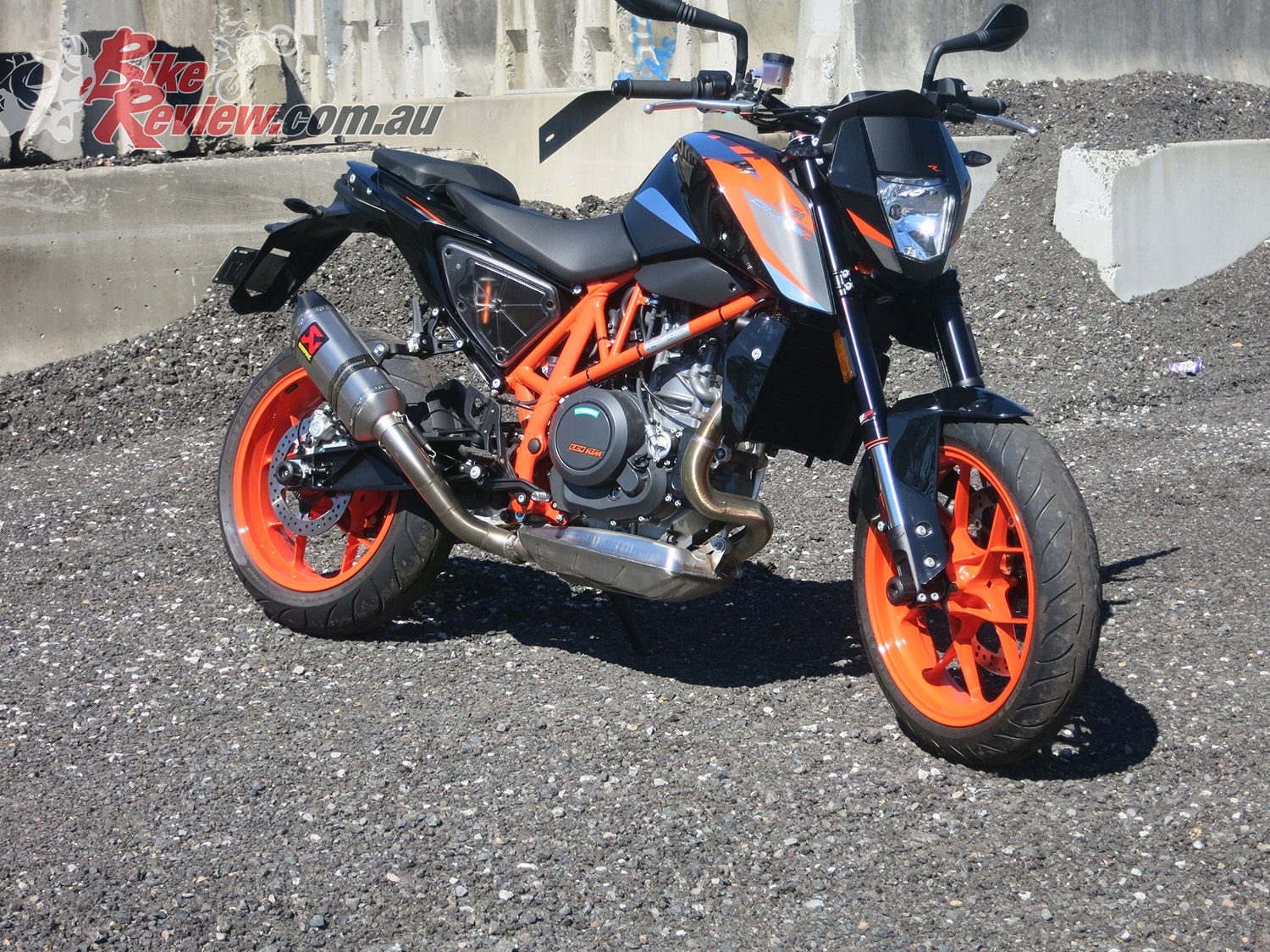
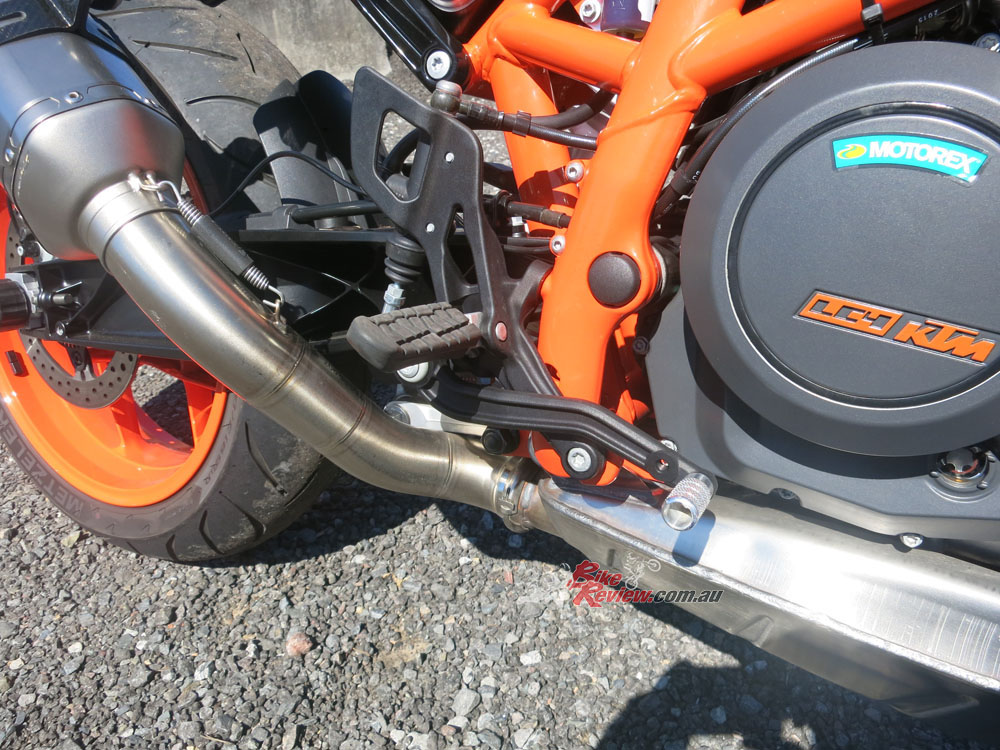
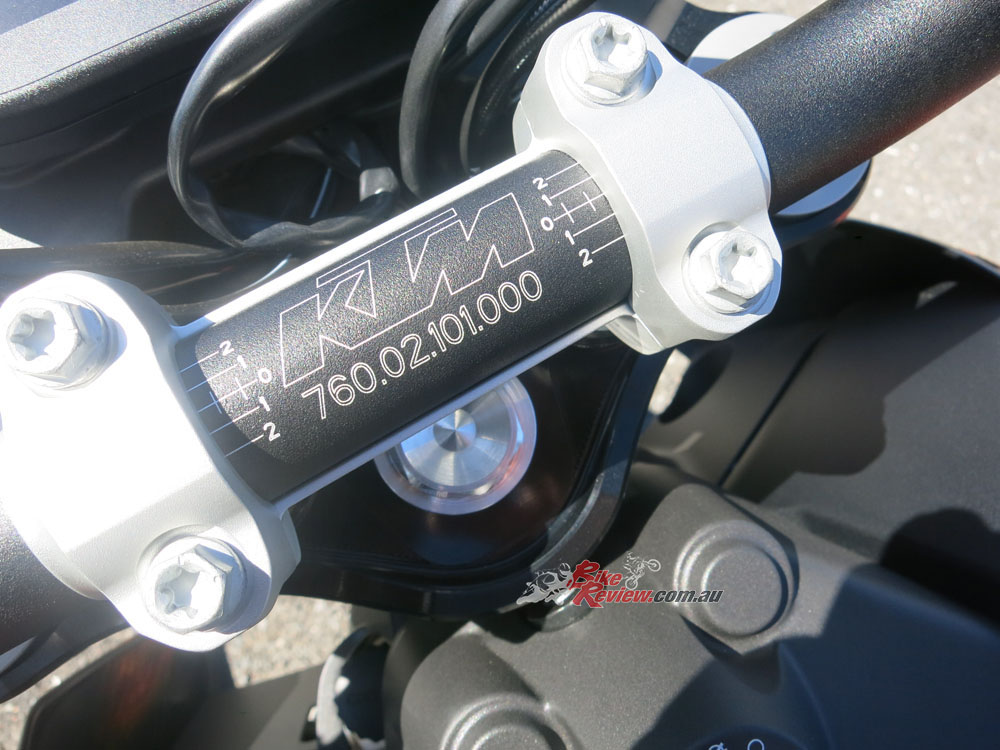
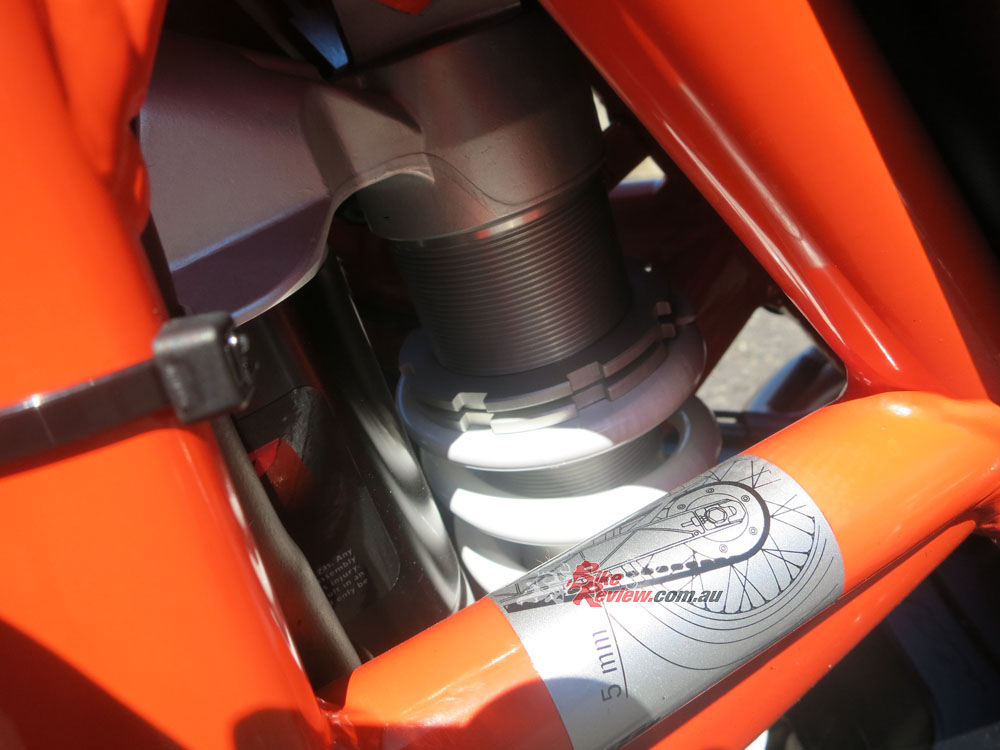
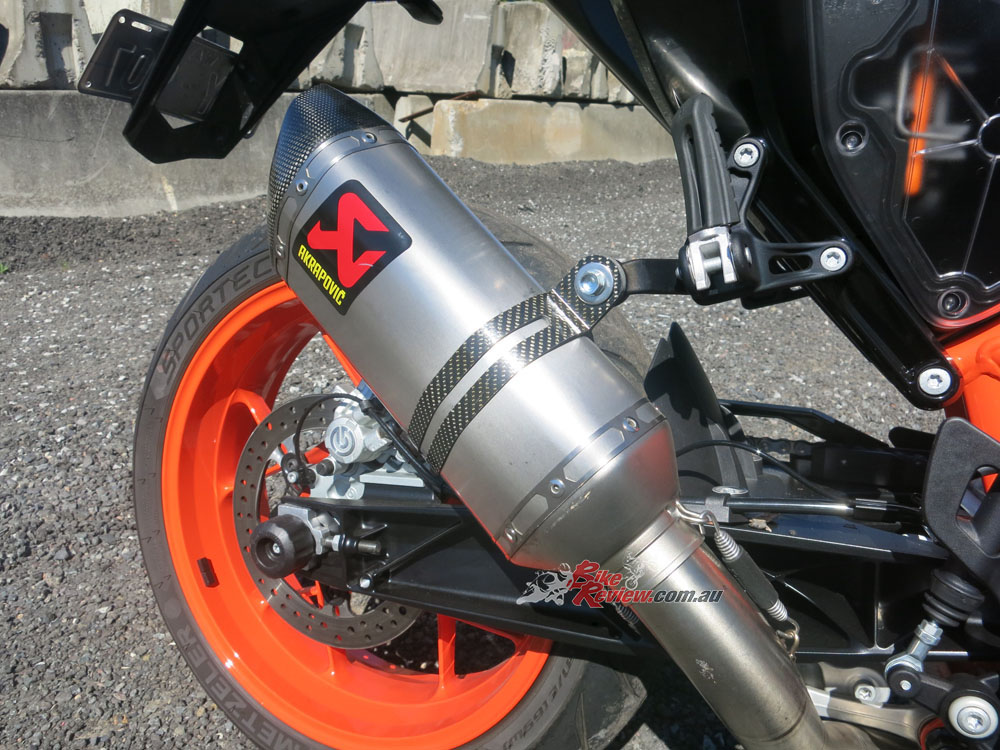
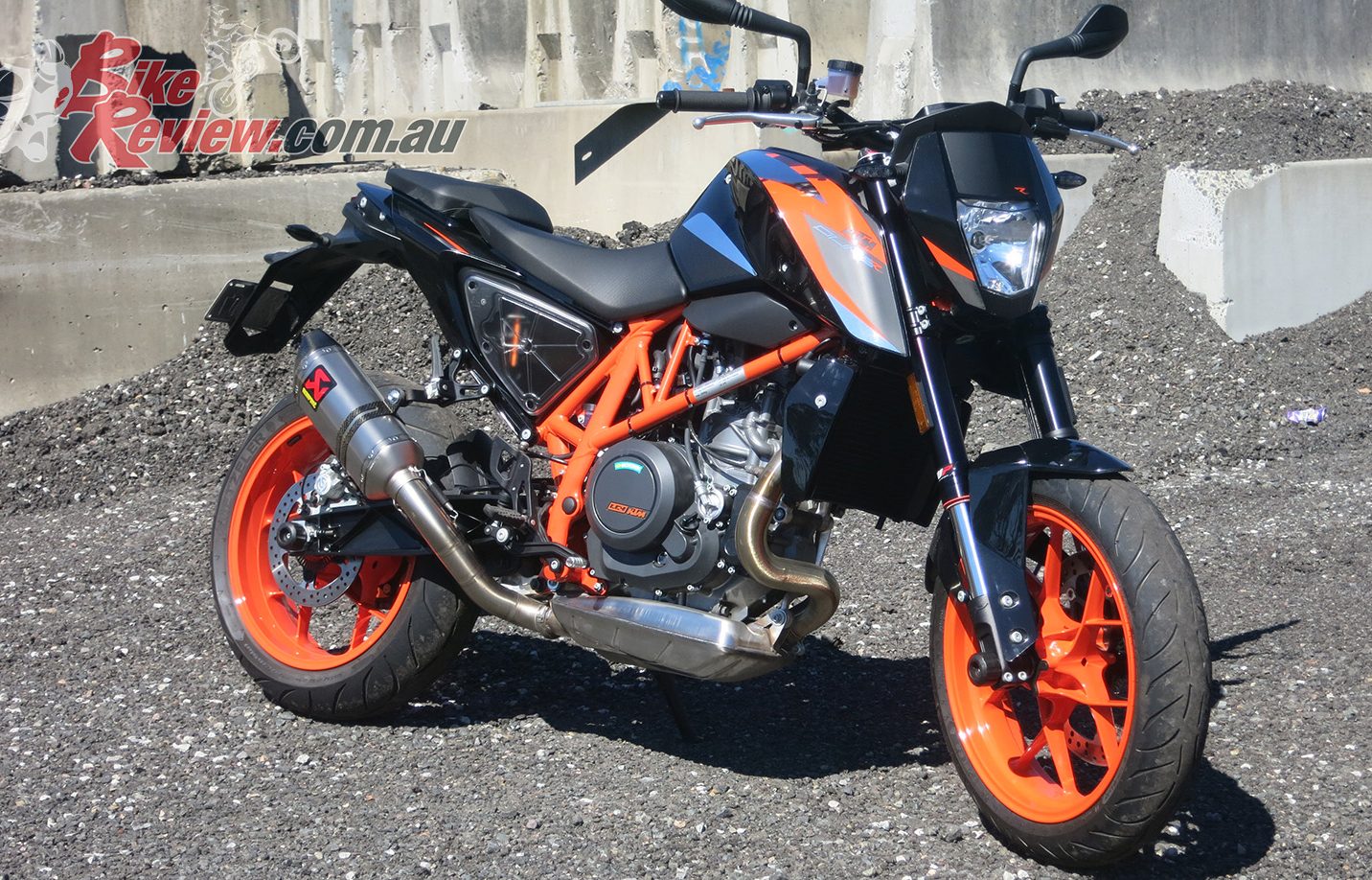
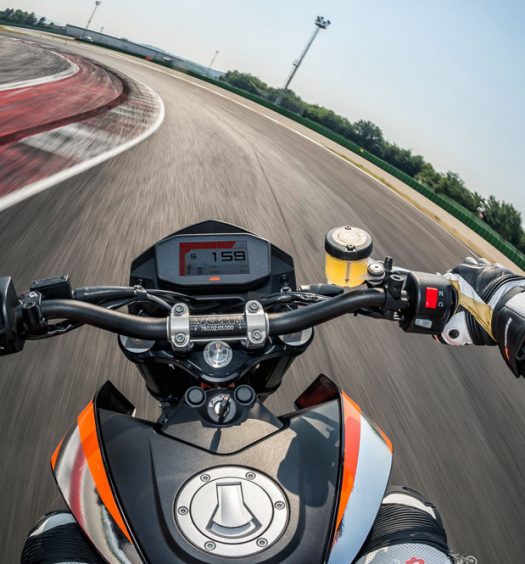
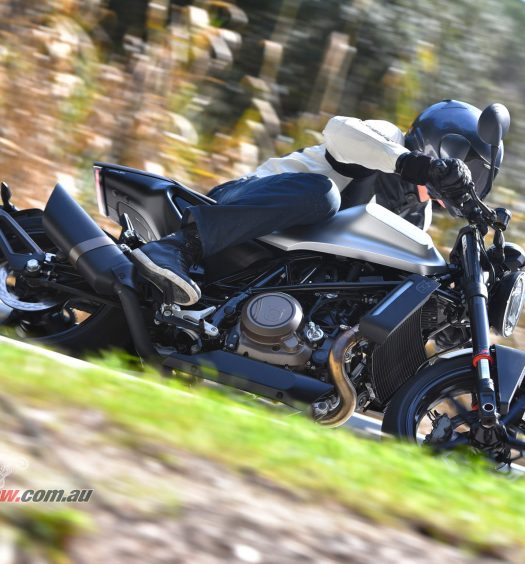





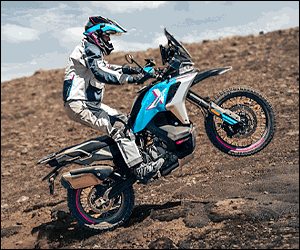








December 13, 2017
At $10995 ride away with 300kms on the clock, would it be a great value for money bike? There is one available and I am really unsure.
December 14, 2017
Hey Darsan,
Value is always a bit subjective, so it’ll vary from person to person. Is that a 2015 model you’re looking at with just 300km on the clock. The only thing to consider if it’s been sitting unused for long periods is whether it’s been properly serviced/taken care of.
Apart from that, it would seem like a good deal considering the regular RRP on one of these bikes. They are an awesome fun machine, so it’d be hard to go wrong with a practically new one.
November 1, 2018
Sorry for the late reply. I did end up getting early this year. Definitely has the fun factor and great to ride. Thanks for your advice
November 1, 2018
Nice stuff!